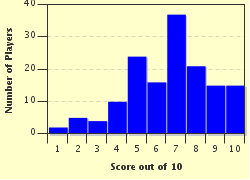Quiz Answer Key and Fun Facts
1. Abracadabra? Hocus pocus? Did Merlin turn a Roman legion to stone? Or was it Pope Cornelius? What is the name given to a megalithic site in Brittany? (A former "Tonight Show" host would know.)
2. Oy vey! An illuminated manuscript from the 15th century has puzzled cryptographers since it came to light in 1912. Which of these is it?
3. Could this have been the basis for the Atlantis legend? What Greek city was destroyed by a tsunami in 373 BC and not found again until 2001?
4. In 1900, what has come to be known as the Antikythera Mechanism was found in an ancient Greek shipwreck. What is it?
5. I say, old chap, did this lens fall from your monocle? Where was a mysterious ancient lens found? (It sounds like an ancient king or a socially inept person.)
6. A series of man-made caves was discovered in southern China in 1992 that cover 322,000 square feet. How long will it take you to figure out the name?
7. Don't get all balled up, but which archeological site in Lebanon has some of the most impressive Roman ruins on earth?
8. Despite their industriousness, one of the three oldest world civilizations completely vanished over a few hundred years. Can you guess which one?
9. Easter Island is a strange place, sitting in the middle of the Pacific Ocean, with its strange stone statues. Another strange thing about the island is called rongorongo. Can you read what it might be?
10. The world's oldest religious temple may be a place called Gobekli Tepe. Do you know where it is?
Source: Author
CmdrK
This quiz was reviewed by FunTrivia editor
bloomsby before going online.
Any errors found in FunTrivia content are routinely corrected through our feedback system.

